Lu Yin
Demystifying the Roles of LLM Layers in Retrieval, Knowledge, and Reasoning
Oct 02, 2025Abstract:Recent studies suggest that the deeper layers of Large Language Models (LLMs) contribute little to representation learning and can often be removed without significant performance loss. However, such claims are typically drawn from narrow evaluations and may overlook important aspects of model behavior. In this work, we present a systematic study of depth utilization across diverse dimensions, including evaluation protocols, task categories, and model architectures. Our analysis confirms that very deep layers are generally less effective than earlier ones, but their contributions vary substantially with the evaluation setting. Under likelihood-based metrics without generation, pruning most layers preserves performance, with only the initial few being critical. By contrast, generation-based evaluation uncovers indispensable roles for middle and deeper layers in enabling reasoning and maintaining long-range coherence. We further find that knowledge and retrieval are concentrated in shallow components, whereas reasoning accuracy relies heavily on deeper layers -- yet can be reshaped through distillation. These results highlight that depth usage in LLMs is highly heterogeneous and context-dependent, underscoring the need for task-, metric-, and model-aware perspectives in both interpreting and compressing large models.
Diffusion Language Models Know the Answer Before Decoding
Aug 27, 2025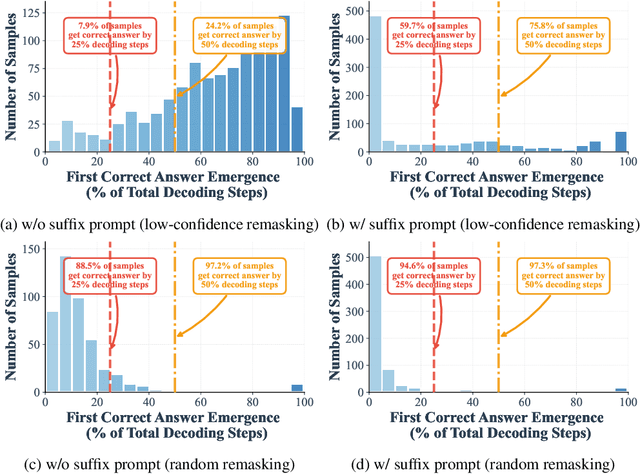
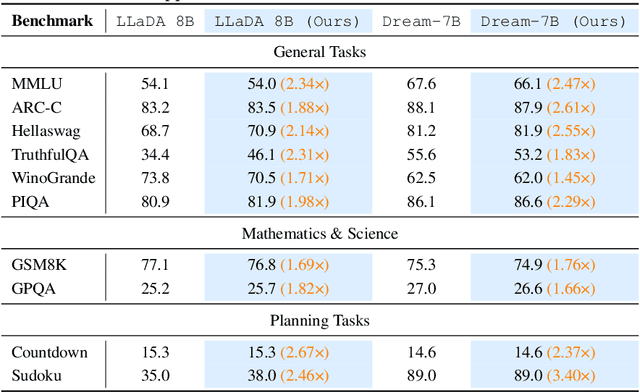
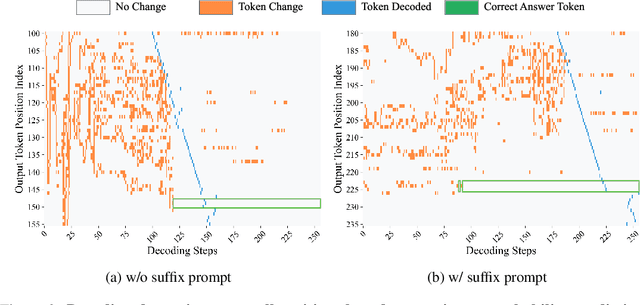
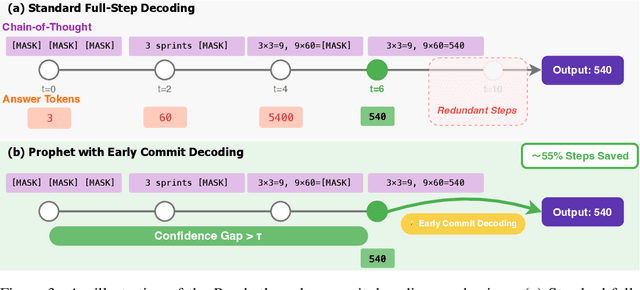
Abstract:Diffusion language models (DLMs) have recently emerged as an alternative to autoregressive approaches, offering parallel sequence generation and flexible token orders. However, their inference remains slower than that of autoregressive models, primarily due to the cost of bidirectional attention and the large number of refinement steps required for high quality outputs. In this work, we highlight and leverage an overlooked property of DLMs early answer convergence: in many cases, the correct answer can be internally identified by half steps before the final decoding step, both under semi-autoregressive and random remasking schedules. For example, on GSM8K and MMLU, up to 97% and 99% of instances, respectively, can be decoded correctly using only half of the refinement steps. Building on this observation, we introduce Prophet, a training-free fast decoding paradigm that enables early commit decoding. Specifically, Prophet dynamically decides whether to continue refinement or to go "all-in" (i.e., decode all remaining tokens in one step), using the confidence gap between the top-2 prediction candidates as the criterion. It integrates seamlessly into existing DLM implementations, incurs negligible overhead, and requires no additional training. Empirical evaluations of LLaDA-8B and Dream-7B across multiple tasks show that Prophet reduces the number of decoding steps by up to 3.4x while preserving high generation quality. These results recast DLM decoding as a problem of when to stop sampling, and demonstrate that early decode convergence provides a simple yet powerful mechanism for accelerating DLM inference, complementary to existing speedup techniques. Our code is publicly available at https://github.com/pixeli99/Prophet.
AlphaDecay:Module-wise Weight Decay for Heavy-Tailed Balancing in LLMs
Jun 17, 2025Abstract:Weight decay is a standard regularization technique for training large language models (LLMs). While it is common to assign a uniform decay rate to every layer, this approach overlooks the structural diversity of LLMs and the varying spectral properties across modules. In this paper, we introduce AlphaDecay, a simple yet effective method that adaptively assigns different weight decay strengths to each module of an LLM. Our approach is guided by Heavy-Tailed Self-Regularization (HT-SR) theory, which analyzes the empirical spectral density (ESD) of weight correlation matrices to quantify "heavy-tailedness." Modules exhibiting more pronounced heavy-tailed ESDs, reflecting stronger feature learning, are assigned weaker decay, while modules with lighter-tailed spectra receive stronger decay. Our method leverages tailored weight decay assignments to balance the module-wise differences in spectral properties, leading to improved performance. Extensive pre-training tasks with various model sizes from 60M to 1B demonstrate that AlphaDecay achieves better perplexity and generalization than conventional uniform decay and other adaptive decay baselines.
AgentAlign: Navigating Safety Alignment in the Shift from Informative to Agentic Large Language Models
May 29, 2025Abstract:The acquisition of agentic capabilities has transformed LLMs from "knowledge providers" to "action executors", a trend that while expanding LLMs' capability boundaries, significantly increases their susceptibility to malicious use. Previous work has shown that current LLM-based agents execute numerous malicious tasks even without being attacked, indicating a deficiency in agentic use safety alignment during the post-training phase. To address this gap, we propose AgentAlign, a novel framework that leverages abstract behavior chains as a medium for safety alignment data synthesis. By instantiating these behavior chains in simulated environments with diverse tool instances, our framework enables the generation of highly authentic and executable instructions while capturing complex multi-step dynamics. The framework further ensures model utility by proportionally synthesizing benign instructions through non-malicious interpretations of behavior chains, precisely calibrating the boundary between helpfulness and harmlessness. Evaluation results on AgentHarm demonstrate that fine-tuning three families of open-source models using our method substantially improves their safety (35.8% to 79.5% improvement) while minimally impacting or even positively enhancing their helpfulness, outperforming various prompting methods. The dataset and code have both been open-sourced.
Leave it to the Specialist: Repair Sparse LLMs with Sparse Fine-Tuning via Sparsity Evolution
May 29, 2025

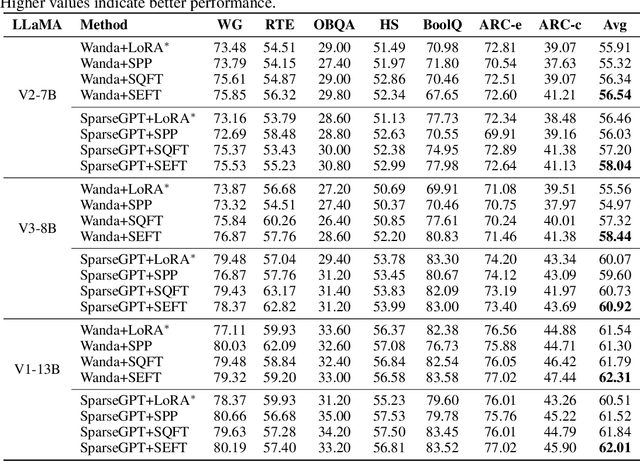
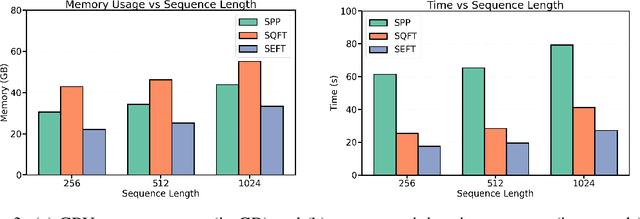
Abstract:Large language models (LLMs) have achieved remarkable success across various tasks but face deployment challenges due to their massive computational demands. While post-training pruning methods like SparseGPT and Wanda can effectively reduce the model size, but struggle to maintain model performance at high sparsity levels, limiting their utility for downstream tasks. Existing fine-tuning methods, such as full fine-tuning and LoRA, fail to preserve sparsity as they require updating the whole dense metrics, not well-suited for sparse LLMs. In this paper, we propose Sparsity Evolution Fine-Tuning (SEFT), a novel method designed specifically for sparse LLMs. SEFT dynamically evolves the sparse topology of pruned models during fine-tuning, while preserving the overall sparsity throughout the process. The strengths of SEFT lie in its ability to perform task-specific adaptation through a weight drop-and-grow strategy, enabling the pruned model to self-adapt its sparse connectivity pattern based on the target dataset. Furthermore, a sensitivity-driven pruning criterion is employed to ensure that the desired sparsity level is consistently maintained throughout fine-tuning. Our experiments on various LLMs, including LLaMA families, DeepSeek, and Mistral, across a diverse set of benchmarks demonstrate that SEFT achieves stronger performance while offering superior memory and time efficiency compared to existing baselines. Our code is publicly available at: https://github.com/QiaoXiao7282/SEFT.
NeuroTrails: Training with Dynamic Sparse Heads as the Key to Effective Ensembling
May 23, 2025Abstract:Model ensembles have long been a cornerstone for improving generalization and robustness in deep learning. However, their effectiveness often comes at the cost of substantial computational overhead. To address this issue, state-of-the-art methods aim to replicate ensemble-class performance without requiring multiple independently trained networks. Unfortunately, these algorithms often still demand considerable compute at inference. In response to these limitations, we introduce $\textbf{NeuroTrails}$, a sparse multi-head architecture with dynamically evolving topology. This unexplored model-agnostic training paradigm improves ensemble performance while reducing the required resources. We analyze the underlying reason for its effectiveness and observe that the various neural trails induced by dynamic sparsity attain a $\textit{Goldilocks zone}$ of prediction diversity. NeuroTrails displays efficacy with convolutional and transformer-based architectures on computer vision and language tasks. Experiments on ResNet-50/ImageNet, LLaMA-350M/C4, among many others, demonstrate increased accuracy and stronger robustness in zero-shot generalization, while requiring significantly fewer parameters.
Seeing and Reasoning with Confidence: Supercharging Multimodal LLMs with an Uncertainty-Aware Agentic Framework
Mar 11, 2025Abstract:Multimodal large language models (MLLMs) show promise in tasks like visual question answering (VQA) but still face challenges in multimodal reasoning. Recent works adapt agentic frameworks or chain-of-thought (CoT) reasoning to improve performance. However, CoT-based multimodal reasoning often demands costly data annotation and fine-tuning, while agentic approaches relying on external tools risk introducing unreliable output from these tools. In this paper, we propose Seeing and Reasoning with Confidence (SRICE), a training-free multimodal reasoning framework that integrates external vision models with uncertainty quantification (UQ) into an MLLM to address these challenges. Specifically, SRICE guides the inference process by allowing MLLM to autonomously select regions of interest through multi-stage interactions with the help of external tools. We propose to use a conformal prediction-based approach to calibrate the output of external tools and select the optimal tool by estimating the uncertainty of an MLLM's output. Our experiment shows that the average improvement of SRICE over the base MLLM is 4.6% on five datasets and the performance on some datasets even outperforms fine-tuning-based methods, revealing the significance of ensuring reliable tool use in an MLLM agent.
CLIMB-3D: Continual Learning for Imbalanced 3D Instance Segmentation
Feb 24, 2025Abstract:While 3D instance segmentation has made significant progress, current methods struggle to address realistic scenarios where new categories emerge over time with natural class imbalance. This limitation stems from existing datasets, which typically feature few well-balanced classes. Although few datasets include unbalanced class annotations, they lack the diverse incremental scenarios necessary for evaluating methods under incremental settings. Addressing these challenges requires frameworks that handle both incremental learning and class imbalance. However, existing methods for 3D incremental segmentation rely heavily on large exemplar replay, focusing only on incremental learning while neglecting class imbalance. Moreover, frequency-based tuning for balanced learning is impractical in these setups due to the lack of prior class statistics. To overcome these limitations, we propose a framework to tackle both \textbf{C}ontinual \textbf{L}earning and class \textbf{Imb}alance for \textbf{3D} instance segmentation (\textbf{CLIMB-3D}). Our proposed approach combines Exemplar Replay (ER), Knowledge Distillation (KD), and a novel Imbalance Correction (IC) module. Unlike prior methods, our framework minimizes ER usage, with KD preventing forgetting and supporting the IC module in compiling past class statistics to balance learning of rare classes during incremental updates. To evaluate our framework, we design three incremental scenarios based on class frequency, semantic similarity, and random grouping that aim to mirror real-world dynamics in 3D environments. Experimental results show that our proposed framework achieves state-of-the-art performance, with an increase of up to 16.76\% in mAP compared to the baseline. Code will be available at: \href{https://github.com/vgthengane/CLIMB3D}{https://github.com/vgthengane/CLIMB3D}
The Curse of Depth in Large Language Models
Feb 09, 2025Abstract:In this paper, we introduce the Curse of Depth, a concept that highlights, explains, and addresses the recent observation in modern Large Language Models(LLMs) where nearly half of the layers are less effective than expected. We first confirm the wide existence of this phenomenon across the most popular families of LLMs such as Llama, Mistral, DeepSeek, and Qwen. Our analysis, theoretically and empirically, identifies that the underlying reason for the ineffectiveness of deep layers in LLMs is the widespread usage of Pre-Layer Normalization (Pre-LN). While Pre-LN stabilizes the training of Transformer LLMs, its output variance exponentially grows with the model depth, which undesirably causes the derivative of the deep Transformer blocks to be an identity matrix, and therefore barely contributes to the training. To resolve this training pitfall, we propose LayerNorm Scaling, which scales the variance of output of the layer normalization inversely by the square root of its depth. This simple modification mitigates the output variance explosion of deeper Transformer layers, improving their contribution. Our experimental results, spanning model sizes from 130M to 1B, demonstrate that LayerNorm Scaling significantly enhances LLM pre-training performance compared to Pre-LN. Moreover, this improvement seamlessly carries over to supervised fine-tuning. All these gains can be attributed to the fact that LayerNorm Scaling enables deeper layers to contribute more effectively during training.
Sebra: Debiasing Through Self-Guided Bias Ranking
Jan 30, 2025



Abstract:Ranking samples by fine-grained estimates of spuriosity (the degree to which spurious cues are present) has recently been shown to significantly benefit bias mitigation, over the traditional binary biased-\textit{vs}-unbiased partitioning of train sets. However, this spuriosity ranking comes with the requirement of human supervision. In this paper, we propose a debiasing framework based on our novel \ul{Se}lf-Guided \ul{B}ias \ul{Ra}nking (\emph{Sebra}), that mitigates biases (spurious correlations) via an automatic ranking of data points by spuriosity within their respective classes. Sebra leverages a key local symmetry in Empirical Risk Minimization (ERM) training -- the ease of learning a sample via ERM inversely correlates with its spuriousity; the fewer spurious correlations a sample exhibits, the harder it is to learn, and vice versa. However, globally across iterations, ERM tends to deviate from this symmetry. Sebra dynamically steers ERM to correct this deviation, facilitating the sequential learning of attributes in increasing order of difficulty, \ie, decreasing order of spuriosity. As a result, the sequence in which Sebra learns samples naturally provides spuriousity rankings. We use the resulting fine-grained bias characterization in a contrastive learning framework to mitigate biases from multiple sources. Extensive experiments show that Sebra consistently outperforms previous state-of-the-art unsupervised debiasing techniques across multiple standard benchmarks, including UrbanCars, BAR, CelebA, and ImageNet-1K. Code, pre-trained models, and training logs are available at https://kadarsh22.github.io/sebra_iclr25/.
 Add to Chrome
Add to Chrome Add to Firefox
Add to Firefox Add to Edge
Add to Edge